Guerrillero Heroico
 Alberto Korda's photograph of Che Guevara | |
| Artist | Alberto Korda |
|---|---|
| Year | March 5, 1960 |
| Type | Photograph |

Guerrillero Heroico (English: "Heroic Guerrilla Fighter") is an iconic photograph of Marxist revolutionary Che Guevara taken by Alberto Korda. It was captured on March 5, 1960, in Havana, Cuba, at a memorial service for victims of the La Coubre explosion. By the end of the 1960s, the image, in conjunction with Guevara's subsequent actions and eventual execution, helped solidify the charismatic and controversial leader as a cultural icon.[2] Korda has said that at the moment he shot the picture, he was drawn to Guevara's facial expression, which showed "absolute implacability"[3] as well as anger and pain.[4] Years later, Korda would say that the photo showed Che's firm and stoic character.[5] Guevara was 31 years old at the time the photo was taken.
Emphasizing the image's ubiquitous nature and wide appeal, the Maryland Institute College of Art called the picture a symbol of the 20th century and the world's most famous photo.[6] Versions of it have been painted, printed, digitized, embroidered, tattooed, silk-screened, sculpted or sketched on nearly every surface imaginable, leading the Victoria and Albert Museum to say that the photo has been reproduced more than any other image in photography.[7] Jonathan Green, director of the UCR/California Museum of Photography, has speculated that "Korda's image has worked its way into languages around the world. It has become an alpha-numeric symbol, a hieroglyph, an instant symbol. It mysteriously reappears whenever there's a conflict. There isn’t anything else in history that serves in this way".[8]
The history and contemporary global impact of the image is the basis for the 2008 documentary Chevolution, directed by Trisha Ziff,[9] along with the 2009 book Che's Afterlife: The Legacy of an Image by Michael Casey.[10]
Origins
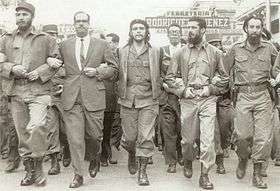
On March 4, 1960, the French freighter La Coubre suspiciously exploded in Havana Harbor, killing up to 100 people and injuring several hundred more.[11] Upon hearing the blast, Guevara rushed to the harbor to board the burning ship, angrily forcing his way past those concerned for his safety following a secondary explosion.[11]
The following day on March 5, President Fidel Castro blamed the U.S. CIA and called for a memorial service and mass demonstration at Havana's Colón Cemetery, to honor the victims.[11] At the time, Guevara was Minister of Industry in the new government, and Korda was Castro's official photographer. After a funeral march along the seafront boulevard known as Malecón, Fidel Castro gave a eulogy for the fallen at a stage on 23rd street.[12] Castro gave a fiery speech, using the words "Patria o Muerte" ("Homeland or Death") for the first time.[13] Meanwhile, at 11:20 am, Guevara came into view for a few seconds. Korda snapped just two frames of him from a distance of about 25–30 ft (7.6–9.1 m) before he disappeared from sight.[12] Korda immediately realised his photograph had the attributes of a portrait.[14] Later, Korda said of this photograph, "I remember it as if it were today … seeing him framed in the viewfinder, with that expression. I am still startled by the impact … it shakes me so powerfully".[7]

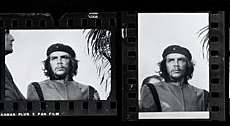
During the rally, Korda took pictures of Cuban dignitaries and famous French existentialist philosophers Jean-Paul Sartre and Simone de Beauvoir, both admirers of Guevara at the time. Included in the film roll were shots of all the speakers and two pictures of Che's brief appearance. The classic picture appears on frame number 40 shot horizontally.[15]
The first photo had Guevara framed alone between an anonymous silhouette and a palm tree; the second with someone's head appearing above his shoulder. The first picture, with the intruding material cropped out, became Guevara's most famous portrait. The editor of Revolución where Korda worked, decided to use only his shots of Castro, Sartre, and Beauvoir, while sending the Che shot back to Korda. Believing the image was powerful, Korda made a cropped version for himself, which he enlarged and hung on his wall next to a portrait of the Chilean poet Pablo Neruda,[13] and also gave copies to some others as a gift. It was not until 1986 that José Figueroa, an established photographer in his own right who printed for Korda and was his unofficially "adopted" son, suggested they try printing the full frame version of the portrait. Korda continued to print both versions of the image up until his death.[16]

To take the photo, Korda used a Leica M2 with a 90 mm lens, loaded with Kodak Plus-X pan film. In speaking about the method, Korda remarked that "this photograph is not the product of knowledge or technique. It was really coincidence, pure luck."[17]
Alberto Korda
As a lifelong communist and supporter of the Cuban Revolution until his death, Alberto Korda claimed no payment for his picture. A modified version of the portrait through the decades was also reproduced on a range of different media, though Korda never asked for royalties. Korda reasoned that Che's image represented his revolutionary ideals, and thus the more his picture spread the greater the chance Che's ideals would spread as well. Korda's refusal to seek royalties for the vast circulation of his photograph "helped it become the ultimate symbol of Marxist revolution and anti-imperialist struggle."[18]
However, Korda did not want commercialization of the image in relation to products he believed Guevara would not support, especially alcohol. This belief was displayed for the first time in 2000, when in response to Smirnoff using Che's picture in a vodka commercial, Korda claimed his moral rights (a form of copyright law) and sued advertising agency Lowe Lintas and Rex Features, the company that supplied the photograph.[19] Lintas and Rex claimed that the image was in the public domain. The final result was an out of court settlement for USD $50,000 to Korda,[20] which he donated to the Cuban healthcare system, stating "if Che was still alive, he would have done the same."[21]
After the settlement, Korda reiterated that he was not against its propagation altogether, telling reporters:
"As a supporter of the ideals for which Che Guevara died, I am not averse to its reproduction by those who wish to propagate his memory and the cause of social justice throughout the world, but I am categorically against the exploitation of Che's image for the promotion of products such as alcohol, or for any purpose that denigrates the reputation of Che."[14]
Giangiacomo Feltrinelli
Passed out to the occasional friend and published in a few small Cuban publications, Che's image remained relatively unknown for 7 years. A print was sold or given to wealthy Italian publisher and intellectual Giangiacomo Feltrinelli in 1967. Feltrinelli had just returned from Bolivia where he had hoped his fame would help in negotiating the release of French journalist and professor Régis Debray. Debray had been arrested in Bolivia in connection with guerrilla operations led by Che Guevara. As Guevara's eventual capture or death appeared to be imminent with the CIA closing in on his whereabouts, Feltrinelli acquired the rights to publish Che's captured Bolivian Diary. At this time Feltrinelli asked Cuban officials where to obtain Guevara images and was directed to Korda's studio where he presented a letter of introduction from the government. The document asked for Korda's assistance in finding a good portrait of Che. Korda knew right away that his favorite image of Che was perfect and pointed to the 1960 shot of Che hanging on the wall, saying that the photo was the best of those he had taken of Che. Feltrinelli agreed and ordered 2 prints. When he returned the next day to pick them up Korda told him that because he was a friend of the revolution he did not have to pay.
Upon his return to Italy, Feltrinelli disseminated thousands of copies of the poster to raise awareness of Che's precarious situation and impending demise. Later in 1968 after his October 9, 1967 execution, Che's Bolivian Diary with Korda's photo on the cover was released worldwide. Feltrinelli also created posters to promote the book, crediting the copyright to (c) Libreria Feltrinelli 1967 (in the lower left hand corner of the image) with no mention of Korda.[16] By this time, Korda's image had officially entered the public consciousness. Alberto Korda later expounded that if Feltrinelli had paid him just one lira for each reproduction, that he would have received millions. However, Korda also expressed that he forgave him, because through his actions, the image became famous.[12]
Milan 1967
Feltrinelli's version of the image was used in October 1967 in Milan, Italy, when spontaneous protests occurred in response to the news of Che's death. Italian photographer Giorgio Mondolfo later stated that "the first time I saw the picture by Alberto Korda, I was not even slightly interested in the author. I was only fifteen, and it was the picture that had drawn us – many for the first time – to gather in the streets, crying Che lives!"[22]
Paris Match
Guerrillero Heroico also appeared in the August 1967 issue of Paris Match. Published only a few months before his eventual capture and execution, the issue featured a major article titled "Les Guerrilleros" by journalist Jean Lartéguy. Lartéguy wrote "At a time when Cuban revolutionaries want to create Vietnams all over the world, the Americans run the risk of finding their own Algeria in Latin America."[23] The article ended by asking "Where is Che Guevara?" The caption of the photo read "The official photograph of Che Guevara; on his beret the star, the symbol of the Comandante."[23] It is not known who provided the magazine with the image, and it was also not credited to Feltrinelli. However, with its wide circulation throughout Europe, and its status as an influential news journal, Paris Match could also be viewed as one of the original purveyors of the image.
Riots
During the May 1968 Paris student riots, which eventually shook the de Gaulle government (but did not overthrow it), organizer "Danny The Red" utilized Fitzpatrick's rendition of Che during the protests. At this time, Che's image was picked up by the Dutch Anarchist group "The Provos" in Amsterdam, who focused on triggering violent responses from authorities through non-violent means.
Jim Fitzpatrick
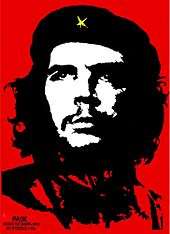
In 1967, Irish artist Jim Fitzpatrick was also using Korda's image as a basis for creating his own stylized posters. Fitzpatrick claims he received a copy of the photograph from the Dutch anarchist group "the Provos", who produced a magazine bearing the group's name. Fitzpatrick remembers that Provo magazine claimed the image originally came to Europe via Jean-Paul Sartre. Fitzpatrick's source of the image, then, would not have been Feltrinelli.[16]
"The first image I did of Che was psychedelic, it looks like he is in seaweed. His hair was not hair, it was shapes that I felt gave it an extra dimension. That was the image I produced for the magazine and that was done before he died and that is the important thing about that image. At first it did not print. It was considered far too strong and revolutionary. I was very inspired by Che's trip to Bolivia. He went there with the intent to overthrow the intensely corrupt government, helped by the Americans at the time, and that's where he died. I thought he was one of the greatest men who ever lived and I still do in many ways. And when he was murdered, I decided I wanted to do something about it, so I created the poster. I felt this image had to come out, or he would not be commemorated otherwise, he would go where heroes go, which is usually into anonymity."— Jim Fitzpatrick, 2005[24]
To create the image Fitzpatrick made a paper negative on a piece of equipment called a grant. They were then printed in one color black and one color red, and he handpainted the star in yellow. Fitzpatrick "wanted the image to breed like rabbits" and hand printed thousands of images to give away to anyone for free in London, in addition to getting friends to pass them out while encouraging others to make their own versions. He printed about a hundred copies at a time to fulfill the demand of political groups in Ireland, France, and the Netherlands who began requesting the image. A batch was also sent to Spain, where they were seized by Franco's police.
Because of the high demand, Fitzpatrick formed a poster company called Two Bear Feet and produced a variety of posters in 1967 using the Korda image. All of them were created without copyright, because Fitzpatrick wanted them to be reproduced. One of these posters would be published in the satirical magazine Private Eye. The best-known was printed on silver foil and was exhibited in an exhibition in London called "Viva Che" at the Arts Laboratory, curated by Peter Meyer. This show was originally to be held at the Lisson Gallery in 1968 and illustrates how fast the image moved from protest into the realm of fine art.[25]
Because of Fitzpatrick's desire for the photo to reflect something of himself, he raised Che's eyes more and added his initial, a reversed "F" on the shoulder. It was not until the 40th anniversary of Che's death that Fitzpatrick admitted to this fact stating "I’m a bit mischievous, so I never told anyone."[26] At this time Fitzpatrick said that "I love the picture and wherever I am in the world, if I see it, I take a photo of it. I always have a chuckle when I see that little 'F'. I know that it's mine."[26] In November 2008, Fitzpatrick announced that he would be signing over the copyright of his Che image to the William Soler Pediatric Cardiology Hospital in Havana, Cuba. In announcing his reason for ensuring all future proceeds would go to the children's hospital, Fitzpatrick stated that "Cuba trains doctors and then sends them around the world … I want their medical system to benefit." Additionally, Fitzpatrick publicized his desire to gift the original artwork to the archive run by Guevara's widow, Aleida March.[27]
Meeting Guevara in Ireland
According to Fitzpatrick, in 1963 while a teenage student at Gormanston College he worked a summer job at the Marine Hotel pub in Kilkee, the remote town of his mother's birth. One morning Che Guevara walked in with two Cubans and ordered an Irish whiskey. Fitzpatrick immediately recognized him because of his interest in the Cuban Revolution. Knowing about the Irish diaspora and history in Argentina, Fitzpatrick asked Che vaguely about his roots. Che told Fitzpatrick that his grandmother was Irish and that his great-grandmother, Isabel, was from Galway, with other family being from Cork.
"I am in this green Ireland of your ancestors. When they found out, the television station came to ask me about the Lynch genealogy, but in case they were horse thieves or something like that, I didn't say much."
— Che Guevara, jokingly in a letter to his father [28]
Guevara's father also bore the Irish surname "Lynch." Fitzpatrick describes Che as "curious" about Ireland "from a revolutionary point of view" and remarks that Che proclaimed his "great admiration" for the fact that, in his view, Ireland was the first country to "shake off the shackles of the British Empire".[24] Apparently Che was stranded on an overnight flight from Moscow to Cuba, and had touched down at Shannon Airport, where the Soviet airline Aeroflot had a refueling base. Unable to depart because of thick fog, Che and his accompanying Cubans took the day off for an "unofficial" visit. It was this experience, according to Fitzpatrick, that gave him the impetus to follow the future actions of Che, including his ill-fated mission to Bolivia.[24]
In December 2008, Jim Fitzpatrick, along with local historian Anne Holliday and the Shannon Development, announced plans to commemorate Guevara's visit to Ireland, and specifically his time spent in Limerick. Early plans are focused on an exhibition of Guevara's visit at the City Museum, followed by the creation of a "permanent mark" symbolizing his time spent at Hanratty Hotel's – White House pub in Shannonside. Fitzpatrick defended the move by remarking "we want to commemorate the fact Che Guevara spent some very important hours of his life here … this probably was Che's last hurrah."[29]
Sinn Féin president Gerry Adams is interviewed in the 2008 documentary Chevolution about the famous photo. As he speaks, the film shows a montage of Che murals in Belfast, with Adams remarking "I suppose people from my background were drawn to that image, because of what Che Guevara represented."[28]
Cuba
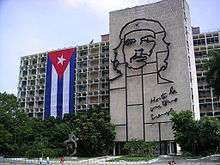
Cuban historian Edmundo Desnoes has stated that "Che's image may be cast aside, bought and sold and deified, but it will form a part of the universal system of the revolutionary struggle, and can recover its original meaning at any moment."[30] That meaning's origin harkens back to when Korda's photo was first published on April 16, 1961, in the daily Cuban newspaper Revolución, advertising a noon conference during which the main speaker was "Dr. Ernesto 'Che' Guevara." The conference was disrupted however, when 1,300 CIA-supported counter-revolutionaries stormed the beaches of Cuba, in what became known as the failed Bay of Pigs invasion. The image was thus republished a second time advertising the newly convened conference on April 28, 1961. Because of this fact, it seems very likely that in the context of both of these publications, that Che could have seen the photograph that would later contribute to his iconic status.[31]
The very first time Cubans on a large scale became familiar with the photograph, despite its earlier reproduction in Revolución, was on hearing the news of Che's murder. Upon the news of Che's execution, it was enlarged and draped on a banner down the five-story building of the Ministry of the Interior in the Plaza de la Revolución in Havana. This building where Che himself had formerly worked, served as a backdrop to Fidel's eulogy on October 18, 1967, publicly acknowledging the death of Che Guevara before a crowd of over a million mourners. José Gómez Fresquet, renowned Cuban poster maker and graphic artist, recalls how on hearing the news of Guevara's death, he immediately worked all night producing the poster to be used at the rally honoring him the next day. Korda had given Fresquet a copy of the portrait as a basis for the poster, which he created on red paper. This was the first privately produced Guerrillero Heroico to be created in Cuba. Since then the building has seen many versions of the image, and today a permanent steel outline, derived from the photograph, adorns the building.[23]
The United States and fame
Guerrillero Heroico made its American debut in 1968 on New York City Subway billboards, when the image appeared in painted form by Paul Davis, for a poster advertising the February issue of Evergreen Review.[32] Paul Davis has stated that he was "inspired by Italian paintings of martyred saints and Christ", in his romanticised version of Che.[32]
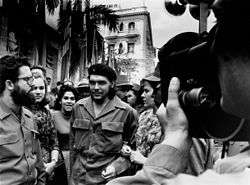
"Che is an impetuous man with burning eyes and profound intelligence who seems born to make revolution."
— Henri Cartier-Bresson, Life magazine, 1963 [33]
"Che was the revolutionary as rock star. Korda, as a fashion photographer, sensed that instinctively, and caught it. Before then, the Nazis were the only political movement to understand the power of glamour and sexual charisma, and exploit it. The communists never got it. Then you have the Cuban revolution, and into this void come these macho guys with straggly hair and beards and big-dick glamour, and suddenly Norman Mailer and all the radical chic crowd are creaming their jeans. Che had them in the palm of his hand, and he knew it. What he didn’t know, of course, was how much that image would define him."
However, the fascination was not solely an American phenomenon. For instance, British journalist Richard Gott who met with Che Guevara several times expressed a similar view, by stating how he was "struck by his magnetic physical attraction, comparable to the aura of a rock star." In Gott's opinion "almost everyone had the same impression, and journalists were particularly susceptible."[35] Time magazine, in an August 8, 1960, cover story after meeting with Guevara displayed this view, by remarking that Che wore "a smile of melancholy sweetness that many women find devastating."[36]
Argentine journalist Julia Costenlos, recalls that in her view he was "blessed with a unique appeal, an incalculable enchantment that came completely naturally."[37] Indian Ambassador K Gajendra Singh, posted in 1965 as a young diplomat in Algiers, recalls his own similar personal encounter with meeting Guevara; describing him as "indisputably the dazzling star of the show" and compared shaking his hand at an economic seminar to "getting an autograph of a celebrity." According to Singh, Che's "charismatic presence in green olive fatigues and black beret" at the time embodied "the very best of the Hollywood and Bollywood stars all rolled into one"[38] Even under duress, The Times journalist Henry Brandon, who spoke with Guevara at the height of the Cuban missile crisis, remarked that Che possessed a "genial charm" that "might have made Charles Boyer envious."[39]
In judging the enduring appeal of the image, Darrel Couturier, representative for Korda since 1997, has opined that it was "the image of a very dashing young man" and that in the "age of free love and flower power … the time was ripe for a figure" or "image that could represent this great diversity in thinking and behavior the world over." According to Couturier, this "age of religious revolution", matched with Guevara's premature death, "elevated him to almost martyrdom."[40]
Influence on art and culture
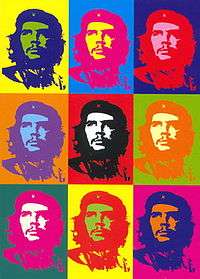
"When you look closely, you can see that many iconic photographs are constructed in the same way; it is possible to copy the formula. Look at some of the most enduring images of our age … Like Che, they are shot from below against a light background, giving them a raised, Godlike quality. The angle of the shot is particularly crucial, as profiles have little impact and full frontals tend to flatten the features. The direction and intensity of the subject's gaze is also key. Che is looking past the camera, out to his vision. His line of vision has been much tinkered with by various artists, but it retains its passion even on a table mat or a screensaver. An image like this is about a sign: it's a shorthand. This particular one now stands for opposition to the establishment, freedom and revolution."
As pop artists took to the image with glee, it evolved into a popular and heavily commercialized icon that often strayed far from Che’s hard-line Marxist message.[42] British pop artist Sir Peter Blake has referred to Guerrillero Heroico as "one of the great icons of the 20th century."[43] When converted into a stark black cut-out, Korda's photograph became easy, cheap, and fast to copy using the favored material and method of the 1960s: lith film and screen painting.[44] By the time of his death in 1967, Che was already "a legend, the romantic epitome of worldwide rebellion" and in the wake of his perceived martyrdom, Korda's photo went viral.[45] Rebellious young people found in it a "sense of empowerment, a crystallization of the perennial idealism of youth."[45]
According to the V&A Museum, "the photograph enshrines Che as a mythic hero. Taken from below, the revolutionary leader with searching eyes and resolute expression becomes larger than life. A perspective that dominates the imagery of social realism, it bears an irresistible aura of authority, independence and defiance."[7] The V&A Museum goes on to state that Korda's famous photograph first deified Che and turned him into an icon of radical chic. Its story, a complex mesh of conflicting narratives, gave Guerrillero Heroico a life of its own, an enduring fascination independent of Che himself.[7] The Italian magazine Skime evokes even more praise, decreeing it "absolutely the most famous of history" while proclaiming that it "captures beauty and youth, courage and generosity, aesthetic and moral virtues of a person who possessed all the characteristics necessary to be converted into a symbol of an epoch like ours, lacking in historic legends and mythic incarnations."[46] Journalist Richard Gott has also remarked that "the red star in Che's beret was up there with 'Lucy in the Sky with Diamonds.'"[35] Jonathan Green, director of the UCR photography museum, has remarked that "pop art is a rejection of traditional figuration, rhetoric, and rendition. Its egalitarian anti-art stance was the perfect corollary for Che's anti-establishment attitude."[47]
Fitzpatrick's graphic was later used in a 1968 painting attributed to Andy Warhol and sold to a gallery in Rome. The painting used the same graphic processes used on the acclaimed Marilyn Monroe pieces. However this painting was a forgery, created by Gerard Malanga who was in need of money. When Warhol heard of the fraud, he "authenticated" the fake, provided that all the money from sales went to him.[48]
Exhibits
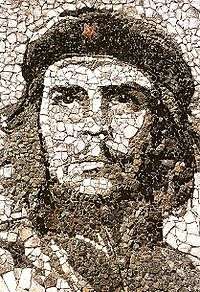
"It is the image of a very dashing young man who was part of a revolution. This was a revolution of the people for the people in a time when there was a great unrest in many parts of the world, particularly in Latin America, Europe and the US. The Vietnam War was raging; students and workers were protesting and striking; it was the age of free love and flower power; it was the pop age; it was the age of religious revolution. The time was ripe for a figure, an image that could represent this great diversity in thinking and behavior the world over. Che's role in the Cuban Revolution made him a revered symbol of world class struggle, equality and freedom from domination and his premature death in 1967 elevated him to almost martyrdom."— Darrel Couturier, Alberto Korda's agent who arranged his first U.S. exhibition in the 1998 [49]
- 1968, the 'Arts Laboratory' in London held an exhibition on the photo titled "Viva Che."[50]
- 1990, the Jour Agnes B Gallery in Paris, France, presented an exhibit of Korda's image titled "Che Guevara: A 21st Century Man."[51]
- 1998, the UCLA Fowler Museum of Cultural History in Los Angeles, California, featured an exhibition compiled by David Kunzle titled "Che Guevara: Icon, Myth and Message."[52]
- 2003, the Centre for Contemporary Art in Rethymnon, Greece, presented an exhibit titled "Che Guevara's Death."[53]
- 2004, the Centro Nacional de la Música, in Buenos Aires, Argentina, held an exhibition titled "Che Guevara by the photographers of the Cuban Revolution."[52]
- 2005, the UCR/California Museum of Photography featured an exhibition titled "Revolution and Commerce: The Legacy of Korda's Portrait of Che Guevara."[54]
- 2005, the International Center of Photography in New York City held an exhibition titled "¡Che! Revolution and Commerce."
- 2006, the Victoria and Albert Museum in London hosted an exhibition titled "Che Guevara: Revolutionary and Icon."[55]
- 2007, the La Triennale in Milan, Italy, featured an exhibition titled "Che Guevara Rebel and Icon: The Legacy of Korda's Portrait."
- 2007, the Tropenmuseum in Amsterdam held a special exhibition about the photograph titled "Che! A Commercial Revolution."
- 2007, the Frost Art Museum at Florida International University in Miami, Florida, presented an exhibition featuring the photo.[56]
- 2008, the WestLicht Gallery in Vienna, Austria, offered an exhibition on Guerrillero Heróico in relation to the "development of a mythos."[57]
- 2008, the Fototeca center in Havana, Cuba, held an exhibition titled "Korda, Known. Unknown."
- 2008, the Santralistanbul in Istanbul, Turkey, hosted the exhibit "Narrative of a Portrait: Korda's Che from Revolution to Icon."[49]
- 2009, the Dom Nashchokina Gallery in Moscow, hosted the exhibition "Che: Hasta Siempre! Meet You in the Eternity" from June 18 to September 20, 2009.[58]
- 2010, the International Center of Photography in New York City, hosted the exhibition "Cuba in Revolution" from November 11 to January 9, 2011 – which featured several versions of the image.[59]
Posters and covers
"It is the photograph that adorns student bedsits across the world. The famed black and white portrait of Ernesto "Che" Guevara perfectly captured his intense stare and brooding good looks, helping establish his myth."
- In 1967 Polish artist Roman Cieslewicz designed a poster with the words "Che Si" (translation: 'Yes Che') emblazoned over his face as eyes and nose. This was later featured on the October 1967 cover of the French art magazine Opus International.
- In 1968, Elena Serrano produced a widely distributed poster titled "Day of the Heroic Guerrilla", which shows telescoping images of Korda's photograph expanding to cover the entire red map of South America.
- The 1968 February issue of Evergreen Review, featured Che's image in a painted form by Paul Davis.
- The September 1969 issue of Tricontinental Magazine featured a conjoined image of Korda's Che with Ho Chi Minh.
- During a 1969 student strike at Berkeley, a poster was produced and distributed with a cartoon bubble coming from Che's mouth possessing the words: "Shut it down!"
- In 1970, the Art Workers' Coalition produced a widely distributed anti-Vietnam War poster featuring an outline of Che on a yellow background, with his famous quotation: "Let me say at the risk of appearing ridiculous, that the true revolutionary is guided by great feelings of love."
- The Rage Against The Machine artwork for their 1993 single, "Bombtrack" features a mirrored version of the iconic two-tone portrait by Jim Fitzpatrick.
- The September 16, 1996 edition of Der Spiegel magazine titled: "The Myth of Che Guevara", featured Che's image adorned with a halo of moving bullets.
- A computerized rendition of Guerrillero Heroico appeared on the cover of the March 1–7, 2006 issue of Metro, above the title "The Blog Revolution."
- In 2003, Madonna's album American Life featured the singer redoing Guerrillero Heroico.
- The December 2008 issue of Rolling Stone Argentina features Guerrillero Heroico on the cover.[61]
Commodity

The Che image has been cited as an example of the merging of politics and marketing and the power that images hold over our society.[42] Trisha Ziff, the curator of a 2004 touring exhibition on the iconography of Che has stated that "Che Guevara has become a brand. And the brand's logo is the image, which represents change. It has become the icon of the outside thinker, at whatever level, whether it is anti-war, pro-green or anti-globalisation. Its presence, everywhere from Belfast to Soweto, or from walls in the Palestinian territories to Parisian boutiques, makes it an image that is out of control. It has become a corporation, an empire, at this point."[62]
Alberto Korda's photo has received wide distribution and modification, appearing on countless numbers of T-shirts, posters, consumer products, protest banners, personal tattoos, and in many other formats. It has morphed into an iconic countercultural symbol for a new generation of youth.[63] The image is now worn on the chests of a diverse group of individuals, from those who truly support the ideals that Che Guevara lived for, to those expressing a more generalized anti-authoritarian stance.[62]
Iconography

If this were a photo session, you couldn't have asked for more. The model, long-haired with steely gaze and wispy guerrillero beard. Jacket zipped to the chin. Collar up and hair uncombed. Jaw set in anger. Beret at a perfect, rakish tilt. There's tension even in his pose: his shoulders turning one way, his face another. And those eyes, mournful but defiant, staring up and to the right as if at some distant vision of the future, or a giant, slow-approaching foe.
Journalist Michael Casey, in his 2009 book Che's Afterlife: The Legacy of an Image, notes how the universal image can be found "in all corners of the world" and theorizes that it arrived as a symbol of rebellion during an era when the world was aching for change.[2] In defining Korda's photo as a "brand" and "quintessential post-modern icon", Casey notes that somehow the photograph encapsulates "hope and beauty," which causes people around the globe to "invest their dreams in it."[2] While David Kunzle, author of the book Che Guevara: Icon, Myth, and Message, has opined that "The beret functions subliminally as a flattened halo."[65]

Trisha Ziff, the curator of Che! Revolution and Commerce describes Guerrillero Heroico as a "statuesque image taken from below," which "derives from a visual language of mythologized heroes harking back to an era of socialist realism" while referencing "a classical Christ-like demeanor."[66] Jon Lee Anderson, author of Che Guevara: A Revolutionary Life, in the photo Che appears "as the ultimate revolutionary icon" with "his eyes staring boldly into the future" and "his expression a virile embodiment of outrage at social injustice."[43]
The stylized image of Che Guevara, adapted from Korda's photograph, is commonly accompanied by several different symbols that add context to its inherent suggested meaning. The most common of these are the red star,[67] hammer and sickle,[68] Cuban flag,[69] and the saying in Spanish "Hasta la Victoria Siempre"[70] (Translation: "Towards Victory, Always"). The multi meaning phrase became the sign off for Che Guevara's numerous letters and speeches as a revolutionary,[71] and represent the commitment to both never give up on the eventual triumph of a Marxist world revolution, and the belief that this victory once it occurs, will be eternal. As a result, "Hasta la Victoria Siempre" has become a de facto slogan or catchphrase,[72] used as a motto by those who continue to support and/or admire Che Guevara's life and/or ideals.[73]
Current legal status
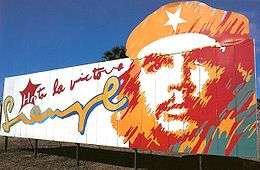
For decades the famous image was unhindered by international copyright agreements, because Cuba was not a signatory to the Berne Convention. Fidel Castro described it as a "bourgeois concept" which meant that artists and advertisers were free to use Korda’s work as they pleased.[42] Legally, Cuban Law no. 156 signed on September 28, 1994, to amend part of Law no. 14 of the 1977 Copyright Act (Article 47), states that pictures taken in Cuba fall into the public domain worldwide, 25 years after their first use.[74] As for the United States, since the image was first published in Cuba without compliance with U.S. copyright formalities and used in Cuba before February 20, 1972 (more than 25 years before Cuba signed the Berne Convention in 1997) it is also generally, although not universally, considered to be in the public domain.
Despite conflicting claims about whether or not the image could have copyright established, Korda's children have sought to control commercial use of the image from defamation. Korda's daughter Diana Diaz pursued a 2003 lawsuit in France against a Paris-based press rights group Reporters Without Borders, for using the Che photograph in a poster campaign decrying Cuba as "the world's largest jail", aimed at dissuading French tourists from vacationing in Cuba after the jailing of 29 dissident journalists.[75] In suing the group for 1.14 million euros, Diaz's lawyer, Randy Yaloz remarked that "we are going after everyone who betrays the moral rights of my client".[76] Moral rights are a separate component of copyright law that are not recognized in the U.S., but are recognized in some other countries, notably in France where Diaz filed the lawsuit.[77] Moral rights aim to protect the integrity of a work from defamation, distortion, slander, or offensive mutilation, even if the originator no longer owns the copyright.[77] However, Reporters Without Borders stopped using the image before any legal judgment was rendered.[76]
Ariana Hernández-Reguant addressed the image's copyright status in 2004 in her article Copyrighting Che: Art and Authorship under Cuban Late Socialism. She expressed a skeptical view towards Korda's heirs being able to establish ownership over the image, noting in reference to the lawsuits involving the image, "There was never any official ruling on whether the depiction constituted a violation of copyright." The author goes on to state that: "Korda took the picture while working for a state-run newspaper, his actual property rights would be questionable under both Cuban and international law."[78]
"We're not after money, we just don't want him misused. He can be a universal person, but respect the image."
— Aleida Guevara, Che's daughter [79]
In 2007, law student Sarah Levy also addressed the potential legal status of the image in Cuba. It was her ultimate contention that "in Cuba the copyright protection in Korda's Guevara photograph would have already expired, and despite the claims of ownership from Korda's heirs, the State would now hold any rights associated with the photograph."[80] In regards to the more commonly disseminated stylized version of the photo, lawyers say it will be an uphill struggle to deter non-photographic use of such a widely reproduced image, other than in countries like Italy where laws protect image rights.[75]
Guevara's heirs also believe they have legal justification to prevent the image's "exploitation" or slander. Guevara's Cuban widow Aleida March stated in 2005 that "We have a plan to deal with the misuse. We can't attack everyone with lances like Don Quixote, but we can try to maintain the ethics of Guevara's legacy."[75] In reference to this pronouncement, Guevara's daughter Aleida Guevara told Reuters, "It will be costly and difficult because each country has different laws, but a limit has to be drawn."[75] However, the family has not yet mounted any court challenges, and no determination of legal copyright internationally has been established.
Further reading and viewing
- Main article: List of works related to Che Guevara
Books
- Alberto Korda: A Revolutionary Lens, by Diana Diaz & Mark Sanders, Steidl, 2007, ISBN 3-86521-458-4
- Che's Afterlife: The Legacy of an Image, by Michael Casey, Vintage Books USA, 2009, ISBN 0-307-27930-8
- Che Guevara: Revolutionary and Icon, by Trisha Ziff, Abrams Image, 2006, ISBN 0-8109-5718-3
- Che: Images of a Revolutionary, by Oscar Sola, Pluto Press, 2000, ISBN 0-7453-1700-6
- Che: The Photobiography of Che Guevara, Thunder's Mouth Press, 1998, ISBN 1-56025-187-5
- Cuba by Korda, by Christophe Loviny & Alberto Korda, Ocean Press (AU), 2006, ISBN 1-920888-64-0
- Self Portrait Che Guevara, by Ernesto Guevara & Victor Casaus, Ocean Press (AU), 2004, ISBN 1-876175-82-6
Films
- Che Guevara: Kordavision, 2008 (87 min). Directed by Hector Cruz Sandoval.
- Chevolution, 2008, Produced by Trisha Ziff & Directed by Luis Lopez, Red Envelope Entertainment.[81][82]
- Personal Che, 2008, Directed by Adriana Mariño and Douglas Duarte.[83]
References
- ↑ Brand Che: Revolutionary as Marketer's Dream by Michiko Kakutani, The New York Times, April 20, 2009
- 1 2 3 Communists, Capitalists still buy into Iconic Che Photo, Author says by Brian Byrnes, CNN, May 5, 2009
- ↑ Che Guevara: A Revolutionary Life, by Jon Lee Anderson, 1997, pg 465
- ↑ Che Guevara: Revolutionary & Icon, by Trisha Ziff, Abrams Image, 2006, pg 15
- ↑ "Che Guevara: Revolutionary & Icon", by Trisha Ziff, Abrams Image, 2006, pg 33
- ↑ Maryland Institute of Art, referenced at BBC News, "Che Guevara photographer dies", May 26, 2001. Online at BBC News, accessed January 4, 2006.
- 1 2 3 4 "V&A: The story of an image, exhibition organised by UCR/California Museum of Photography". Vam.ac.uk. Retrieved 2011-03-05.
- ↑ "Che as revolutionary and icon, by Corinna Lotz". Aworldtowin.net. Retrieved 2011-03-05.
- ↑ DVD Review: Chevolution by David Van Der Haeghen, DVD Town, January 16, 2010
- ↑ Brand Che: Revolutionary as Marketer’s Dream by Michiko Kakutani, The New York Times, April 20, 2009
- 1 2 3 Che Guevara: A Revolutionary Life, by Jon Lee Anderson, 1997, pg 442
- 1 2 3 Obit: Alberto Korda The Times, May 28, 2001
- 1 2 Iconic Photo of Che Guevara Now Half a Century Old by the Latin American Herald Tribune, March 5, 2010
- 1 2 "''The Making of an Icon: Forty Years'', Sunday Herald, Oct 7 2007". Findarticles.com. October 7, 2007. Retrieved 2011-03-05.
- ↑ "El Guerrillero Heroico (1960)" by Emilio Brizzi, On Photography And More, February 5, 2007
- 1 2 3 Introduction: Korda's Che Moves Out into the World by Trisha Ziff, January 2005
- ↑ Alberto Korda at The Art History Archive by Brandi Leigh, November 2007
- ↑ Cuba, 5 March 1960: Alberto Korda by Ian K Smith, New Statesman, April 1, 2010
- ↑ After 40 Years and Millions of Posters, Che's Photographer Sues for Copyright by Matt Wells, The Guardian, August 7, 2000
- ↑ Ariana Hernández-Reguant, Copyrighting Che: Art and Authorship under Cuban Late Socialism, Public Culture 2004 v. 16 pp. 1–30. pg 4
- ↑ Cuba's Che Photographer Korda Dies in Paris by Andrew Cawthorne, Reuters, May 25, 2001
- ↑ The 150th Anniversary of Photography catalogue, an exhibition curated by Guiliana Scimè, Pier Paolo Pasolini, 1988.
- 1 2 3 "Che Guevara: Revolutionary & Icon", by Trisha Ziff, Abrams Image, 2006, pg 19
- 1 2 3 "A phone conversation between Aleksandra Mir and Jim Fitzpatrick, (Dublin), January 3, 2005". Aleksandramir.info. Retrieved 2011-03-05.
- ↑ "Che Guevara: Revolutionary & Icon", by Trisha Ziff, Abrams Image, 2006, pg 21
- 1 2 Artist reveals his guerrilla tactics with iconic image’s secret mark, by Web Studio Ireland, October 9, 2007
- ↑ The Diary, Ken Sweeney – Che and Share Alike, says Jim November 30, 2008
- 1 2 Gerry Adams Featured in New Che Guevara Documentary by Kenneth Haynes, Irish Central, September 8, 2009
- ↑ Marking Che Guevara's Limerick Link Limerick Leader, December 4, 2008
- ↑ "Shaykh Che Guevara" Q-News, July 2006, Issue 367, pg 80
- ↑ "Che Guevara: Revolutionary & Icon", by Trisha Ziff, Abrams Image, 2006, pg 16
- 1 2 "Che Guevara: Revolutionary & Icon", by Trisha Ziff, Abrams Image, 2006, pg 22
- ↑ This is Castro’s Cuba Seen Face to Face, by Henri Cartier-Bresson, Life magazine, March 15, 1963, pg 41
- ↑ "Che Guevara: Revolutionary & Icon", by Trisha Ziff, Abrams Image, 2006, pg 73
- 1 2 The story of the iconic image of Che Guevara by Richard Gott, The Hindu, June 5, 2006
- ↑ Castro's Brain by Time magazine, August 8, 1960
- ↑ "Poster Boy" by Richard Gott, The Guardian, June 3, 2006
- ↑ A Meeting with Che Guevara by K Gajendra Singh, Global Research, June 14, 2008
- ↑ From the archive: Attack us at your peril, cocky Cuba warns US Times Online, November 2, 2008
- ↑ ‘Korda’s Che from Revolution to Icon’ travels to İstanbul by Rumeysa Kiger, Today's Zaman, October 20, 2008
- ↑ Che: The Artists View by Alison Jackson, New Statesman, June 12, 2006
- 1 2 3 Che: The Birthday of a Revolutionary Brand by Michael J. Casey, The Wall Street Journal, March 5, 2010
- 1 2 Just a Pretty Face? by Sean O'Hagan, The Observer, July 11, 2004
- ↑ "Che Guevara: Revolutionary & Icon", by Trisha Ziff, Abrams Image, 2006, pg 42
- 1 2 A look at Che Guevara through the Lens of his Iconic Image, by Robert W. Butler, The Miami Herald, February 19, 2010
- ↑ "Che Guevara: Revolutionary & Icon", by Trisha Ziff, Abrams Image, 2006, pg 41
- ↑ "Che Guevara: Revolutionary & Icon", by Trisha Ziff, Abrams Image, 2006, pg 75
- ↑ Bourdon, David. "Warhol". Harry N. Abrams Inc, 1989 pg 291
- 1 2 'Korda’s Che from Revolution to Icon' Travels to İstanbul Today's Zaman, November 10, 2008
- ↑ Korda's Che Moves Out into the World by Trisha Ziff, 2005
- ↑ Cubarte. "Cubarte Gallery: Alberto Korda". Galeriacubarte.cult.cu. Retrieved 2011-03-05.
- 1 2 "Exposiciones Colectivas (Selección)". Korda Por Siempre. Retrieved 2011-03-05.
- ↑ "35 years without Che Guevara – Photography Exhibition in Rethymnon". Travel-to-crete.com. Retrieved 2011-03-05.
- ↑ UCR/California Museum of Photography (1960-03-05). "Revolution and Commerce: The Legacy of Korda's Portrait of Che Guevara". Cmp.ucr.edu. Retrieved 2011-03-05.
- ↑ "V&A – Che Guevara: Revolutionary & Icon". Vam.ac.uk. Retrieved 2011-03-05.
- ↑ "Meet the Man Behind the Dorm Room Poster", By Raina McLeod, Miami New Times, January 18, 2007
- ↑ WestLicht Gallery Reconsiders Che Guevara in Photography Exhibit in Vienna from Art Daily
- ↑ Meet Legendary Che Guevara in Moscow June 18, 2009
- ↑ Tumult and Triumph in Black and White by Ken Johnson, The New York Times, November 11, 2010
- ↑ Row rages over iconic image of Che Guevara by Jamie Doward, The Observer, March 7, 2010
- ↑ Rolling Stone Magazine (Argentine edition). December 2008. Missing or empty
|title=(help) - 1 2 Che: The icon and the ad by Stephanie Holmes, October 5, 2007, BBC.
- ↑ Guevara's Last Stand by Chris Bradley, New Statesman, June 12, 2008
- ↑ Capitalizing on Che Guevara's image by Ben Ehrenreich, The Los Angeles Times, June 1, 2008
- ↑ "Che Guevara: Revolutionary & Icon", by Trisha Ziff, Abrams Image, 2006, pg 88
- ↑ Korda's Che Moves Out into the World by Trisha Ziff, UCR exhibit introduction
- ↑ "Che + red star". Retrieved 2011-03-05.
- ↑ "Che + Hammer and Sickle". Retrieved 2011-03-05.
- ↑ "Che + Cuban Flag". Los Angeles Times. Retrieved 2011-03-05.
- ↑ "Che Guevara + ''Hasta la Victoria Siempre''". Retrieved 2011-03-05.
- ↑ Che Guevara monument in Santa Clara
- ↑ "Plaza of the Revolution in Havana, Cuba". Retrieved 2011-03-05.
- ↑ "Remembering Che: Hasta La Victoria Siempre!". Omega.wordpress.com. 2007-10-09. Retrieved 2011-03-05.
- ↑ WIPO Guide to Intellectual Property Worldwide, Issue 479 of WIPO publication, by the World Intellectual Property Organization, 2000, ISBN 92-805-0856-3, pg 144–147
- 1 2 3 4 Reuters, "Che's Family Plans to Fight Use of Famed Photo", Common Dreams, August 29, 2005
- 1 2 Korda Daughter Sues RSF Over Image of Che, by Cuba News, March 2004
- 1 2 Intellectual Property Rights: Critical Concepts in Law, Volume 2, by D. Vaver, Taylor & Francis, 2006, ISBN 0-415-33089-0, pg 273–280
- ↑ Hernandez-Reguant, Ariana. "Copyrighting Che: Art and Authorship under Cuban Late Socialism". Public Culture – Volume 16, Number 1, Winter 2004, pp. 1–29, – pp. 4
- ↑ 40 Years After Che Guevara's Death, his Image is a Battleground by Marc Lacey, The New York Times, October 8, 2007
- ↑ "A Copyright Revolution: Protecting the Famous Photograph of Che Guevara", by Sarah Levy, 13 Law and Business Review of the Americas, Am. 687. Summer of 2007.
- ↑ Tribeca Review: Chevolution by Joel Keller, April 27, 2008.
- ↑ Review: Chevolution by Daniel Zugna, March 16, 2010
- ↑ Official Website of "Personal Che" directed by Adriana Mariño & Douglas Duarte
External links
| Wikimedia Commons has media related to Guerrillero Heroico. |
| Wikimedia Commons has media related to Derivative works of Guerrillero Heroico. |
- BBC: Che: The Icon and the Ad, by Stephanie Holmes, October 5, 2007
- CNN Video: Examining an Iconic Image
- Gallery of Pictures from The Guardian
- Guerrillero Heroico: a Brief History by Trisha Ziff
- Che Guevara Spray Paint Stencil
- Che's Afterlife: The Legacy of an Image by Michael Casey – image collection from the book
- MSNBC: Che Guevara, Revolutionary or Chic Icon? by Tyler Vaughn, August 14, 2006
- Washington Post: Che Guevara's Iconic Image Endures by Martha Irvine, Sept 23 2006
